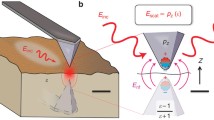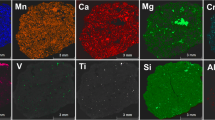Abstract
During the past two decades, several studies of fluid inclusions hosted in some opaque ore minerals using near-infrared microscopy have been performed. Results indicated that this method can be applied to several sulfidic ores and metal oxides depending on their electronic band structures and infrared-active vibration modes. Infrared transmittance of individual ore minerals can be best characterized using Fourier transform infrared spectroscopy. Infrared microscopic observations are limited to the near-infrared region to about 2.3 μm depending on the IR sensitivity of the IR camera. The trace element content in ore minerals can be another limiting factor for optical observations in near-infrared light. Still, IR transmittance gradually decreases upon heating caused by shifting of IR absorption edges for higher wavelengths. Possibilities and limitations of studying fluid inclusions hosted in opaque minerals by near-infrared light microthermometry and laser ablation-inductively coupled plasma-mass spectrometry (LA-ICP-MS) are discussed.














Similar content being viewed by others
References
Ault AK, Reiners PW, Evans JP, Thompson SN (2015) Linking hematite (U/Th)/He dating with the microtextural record of seismicity in the Wasatch fault damage zone, Utah, USA. Geology 43:771–774
Bai X-J, Wang M, Jiang Y-D, Qiu H-N (2013) Direct dating of tin–tungsten mineralization of the Piaotang tungsten deposit, South China, by 40Ar/39Ar progressive crushing. Geochim Cosmochim Acta 114:1–12
Bailly L, Bouchot V, Beny C, Milesi J-P (2000) Fluid inclusion study in stibnite using infrared microscopy: example of the Brouzils antimony deposit (Vendée, Armorican Massif, France). Econ Geol 95:221–226
Behr HJ, Horn EE, Frentzel-Beyme K, Reutel C (1987) Fluid inclusion characteristics of the Variscan and post-Variscan mineralizing fluids in the Federal Republic of Germany. Chem Geol 61:273–285
Bodnar RJ, Lecumberri-Sanchez P, Moncada D, Steele-MacInnis M (2014) Fluid inclusions in hydrothermal or deposits. In: Holland HD, Turekian KK (eds) Treatise on geochemistry, vol 13, 2nd edn. Elsevier, Oxford, pp. 119–142
Boldish SI, White WB (1998) Optical band gaps of selected ternary sulfide minerals. Am Mineral 83:865–871
Campbell AR (1991) Geologic applications of infrared microscopy. Soc Sediment Geol, SEPM Short Course 25:161–171
Campbell AR, Panter KS (1990) Comparison of fluid inclusions in coexisting (cogenetic?) wolframite, cassiterite and quartz from St. Michel’s Mount and Cligga Head, Cornwall, England. Geochim Cosmochim Acta 54:673–681
Campbell AR, Robinson-Cook S (1987) Infrared fluid inclusion microthermometry on coexisting wolframite and quartz. Econ Geol 82:1640–1645
Campbell AR, Robinson-Cook S, Amindyas C (1988) Observation of fluid inclusions in wolframite from Panasqueira, Portugal. Bull Mineral 111:251–256
Efstathiou A, Levin ER (1968) Optical properties of As2Se3, (AsxSb1-x)2Se3 and Sb2S3. J Optic Soc Am 58:373–377
Favorov VA, Krasnikov VI, Sychugov VS (1972) Nekotorje faktory, opredelyayusshchie izmenchivost‘ oluprovodnikovykh svoistv pirita i arsenopirita. Izvestiya Akad Nauk SSSR, Seria Geol 11:72–84
Fischer M, Hiller JE (1956) Über den thermoelektrischen Effekt des Pyrits. Neues Jb Mineral 89:281–301
Fleischer M (1955) Minor elements in some sulfide minerals. Econ Geol 50:970–1024
Goldstein RH, Reynolds TJ (1994) Systematics of fluid inclusions in diagenetic minerals. SEPM Short Course:31–199 Tulsa
Hagemann SG, Lüders V (2003) P-T-X conditions of hydrothermal fluids and precipitation mechanism of stibnite-gold mineralization at the Wiluna lode-gold deposits. Western Australia: Conventional and Infrared Microthermometric Constraints: Mineral Deposita 38:936–952
Hawley JE (1952) Spectrographic studies of some Eastern Canada gold mines. Econ Geol 47:778–803
Hunt GR, Salisbury JW, Lenhoff CJ (1971a) Visible and near-infrared spectra of minerals and rocks: III. Oxides and hydroxides. Modern Geol 2:195–205
Hunt GR, Salisbury JW, Lenhoff CJ (1971b) Visible and near-infrared spectra of minerals and rocks: IV. Sulphides and sulfates. Modern Geol 3:1–14
Karasev AP, Krasnikov VI, Pantaev VD, Seifullin RS, Sychugov VS, Favorov VA (1972) Nekotorje elektrofizicheskie svoistva pirita vostochnogo zabaikalia. Akad Nauk SSSR, Sibirskoe Otdelenie, Geol i Geofiz 5:64–71
Keys JD, Horwood GL, Baleshta TM, Cabri LJ, Harris DC (1968) Iron-iron interaction in iron-containing zinc sulfide. Canad Mineral 9:463–467
Kouzmanov K, Bailly L, Ramboz C, Rouer O, Bény J-M (2002) Morphology, origin and infrared microthermometry of fluid inclusions in pyrite from the Radka epithermal copper deposit, Srednogorie zone, Bulgaria. Mineral Deposita 37:599–613
Kouzmanov K, Pettke T, Heinrich CA (2010) Direct analysis of ore-precipitating fluids: combined IR microscopy and LA-ICP-MS study of fluid inclusions in opaque ore minerals. Econ Geol 105:351–373
Kulis J (1999) Trace element control on near-infrared transparency of pyrite. Unpub MS thesis, Socorro, New Mexico Inst Mining Tech, 271 p
Lindaas SE, Kulis J, Campbell AR (2002) Near-infrared observation and microthermometry of pyrite-hosted fluid inclusions. Econ Geol 97:603–618
Lüders V (1996) Contribution of infrared microscopy to fluid inclusion studies in some opaque minerals (wolframite, stibnite, bournonite); metallogenic implications. Econ Geol 91:1462–1468
Lüders V, Ziemann M (1999) Possibilities and limits of infrared light microthermometry applied to studies of pyrite-hosted fluid inclusions. Chem Geol 154:169–178
Lüders V, Gutzmer J, Beukes JB (1999) Fluid inclusion studies in co-genetic hematite, hausmannite and gangue minerals from high-grade manganese ores in the Kalahari manganese filed, South Africa. Econ Geol 94:589–596
Lüders V, Romer RL, Cabral AR, Schmidt C, Banks DA, Schneider J (2005) Genesis of itabirite-hosted Au–Pd–Pt-bearing hematite-(quartz) veins, Quadrilátero Ferrífero, Minas Gerais, Brazil: constraints from fluid inclusion infrared microthermometry, bulk crush-leach analysis and U–Pb systematics. Mineral Deposita 40:289–306
Lüders V, Romer RL, Gilg HA, Bodnar RJ, Pettke T, Misantoni D (2009) A geochemical study of the Sweet Home Mine, Colorado Mineral Belt, USA: hydrothermal fluid evolution above a hypothesized granite cupola. Mineral Deposita 44:415–434
Mancano DP, Campbell AR (1995) Microthermometry of enargite-hosted fluid inclusions from Lepanto, Philippines, high-sulfidation Cu-Au deposit. Geochim Cosmochim Acta 59:3909–3916
Moncada D, Mutchler S, Rimstidt JD, Reynolds TJ, Bodnar RJ (2012) Characteristics and distribution of mineral textures and fluid inclusions in the epithermal Ag-Au deposits at Guanajuato, México. J Geochem Explor 114:20–35
Morelli RM, Creaser RA, Selby D, Kelley KD, Leach DL, King AR (2004) Re–Os sulfide geochronology of the red dog sediment-hosted Zn–Pb–Ag deposit, Brooks Range, Alaska. Econ Geol 99:1569–1576
Moritz R (2006) Fluid salinities obtained by infrared microthermometry of opaque minerals: implications for ore deposit modeling—a note of caution. J Geochem Explor 89:284–287
Nakai S, Halliday AN, Kessler SE, Jones HD, Kyle JR, Lanes TE (1993) Rb-Sr dating of sphalerites from Mississippi Valley-type (MVT) ore deposits. Geochim Cosmochim Acta 57:417–427
Ni P, Wang X-D, Wang G-G, Huang J-B, Pan J-Y, Wang T-G (2015) An infrared microthermometric study of fluid inclusions in coexisting quartz and wolframite from late Mesozoic tungsten deposits in the Gannan metallogenic belt, South China. Ore Geol Rev 65:1062–1077
Pettke T, Diamond LW (1996) Rb-Sr dating of sphalerite based on fluid inclusion—host mineral isochrons: a clarification of why it works. Econ Geol 91:951–956
Pflugbeil B (1995) Mikrothermometrische Untersuchungen an Flüssigkeitseinschlüssen in Wolframiten aus Quarz-Wolframit-Mineralisationen mittels IR-Mikroskopie. Tech Univ Berlin, Unpub Dipl thesis, 59 p
Richards JP, Kerrich R (1993) Observations of zoning and fluid inclusions in pyrite using a transmitted infrared light microscope. Econ Geol 88:716–723
Roedder E, Bodnar RJ (1997) Fluid inclusion studies of hydrothermal ore deposits. In: Barnes HL (ed) Geochemistry of hydrothermal ore deposits, 3rd edn. Wiley & Sons, New York, pp. 657–697
Romer RL, Lüders V (2006) Direct dating of hydrothermal W mineralization: U-Pb age for hübnerite (MnWO4), sweet home mine, Colorado. Geochim Cosmochim Acta 70:4725–4733
Rosière CA, Rios JR (2004) The origin of hematite in high-grade iron ores based on infrared microscopy and fluid inclusion studies: the example of the Conceição mine, Quadrilátero Ferrífero, Brazil. Econ Geol 99:611–624
Schoolar RB, Dixon JR (1965) Optical constants of lead sulfide in the fundamental adsorption edge region. Phys Rev 137:A667–A670
Seehra MS, Seehra SS (1979) Temperature dependence of the band gap of FeS2. Phys Rev B19:6620
Shimizu T, Aoki M, Kabashima T (2003) Near-infrared and visible light microthermometry of fluid inclusions in sphalerite from a possible southeast extension of the Toyoha polymetallic deposit, Japan. Resource Geol 53:115–126
Shuey RT (1975) Semiconducting ore minerals. In: Developments in econ Geol. Elsevier, Amsterdam, Oxford, New York, pp. 4–415
Telkes M (1950) Thermoelectric power and electrical resistivity of minerals. Amer Mineral 35:536–555
Tindle AG, Webb PC (1989) Niobian wolframite from Glen Gairn in the eastern highlands of Scotland: a microprobe investigation. Geochim Cosmochim Acta 53:1921–1935
Wernick JH, Benson KE (1957) New semiconducting ternary compounds. J Phys Chem Solids 3:157–159
Wernicke RS, Lippolt HJ (1994) Dating of vein specularite using internal (U + Th)/4He isochrons. Geophys Res Lett 21:345–347
Wilkinson JJ (2001) Fluid inclusions in hydrothermal ore deposits. Lithos 55:229–272
Woods TL, Roedder E, Bethke PM (1982) Fluid-inclusion data on samples from Creede, Colorado, in relation to mineral paragenesis. USGS Open-file Report:82–313 77 pp
Zhu M-T, Zhang L-C, Wu G, He H-Y, Cui M-L (2013) Fluid inclusions and He-Ar isotopes in pyrite from the Yinjiagou deposit in the southern margin of the North China Craton: a mantle connection for poly-metallic mineralization. Chem Geol 351:1–14
Acknowledgments
I am indebted to the curators of the Naturkundemuseum Berlin, G. Wappler, and R.-T. Schmitt for providing ore mineral samples used for FT-IR spectroscopy and microprobe analysis in this study. I am grateful to D. Rhede and M. Koch-Müller both from GFZ, Potsdam, for microprobe analysis and FT-IR spectroscopy, respectively. P. Möller is thanked for fruitful discussions on semiconducting properties of ore minerals. The attentive reviews by Alfons van den Kerkhof and Matthew Steele-MacInnis are gratefully acknowledged.
Author information
Authors and Affiliations
Corresponding author
Additional information
Editorial handling: B. Lehmann
Rights and permissions
About this article
Cite this article
Lüders, V. Contribution of infrared microscopy to studies of fluid inclusions hosted in some opaque ore minerals: possibilities, limitations, and perspectives. Miner Deposita 52, 663–673 (2017). https://doi.org/10.1007/s00126-016-0694-4
Received:
Accepted:
Published:
Issue Date:
DOI: https://doi.org/10.1007/s00126-016-0694-4




